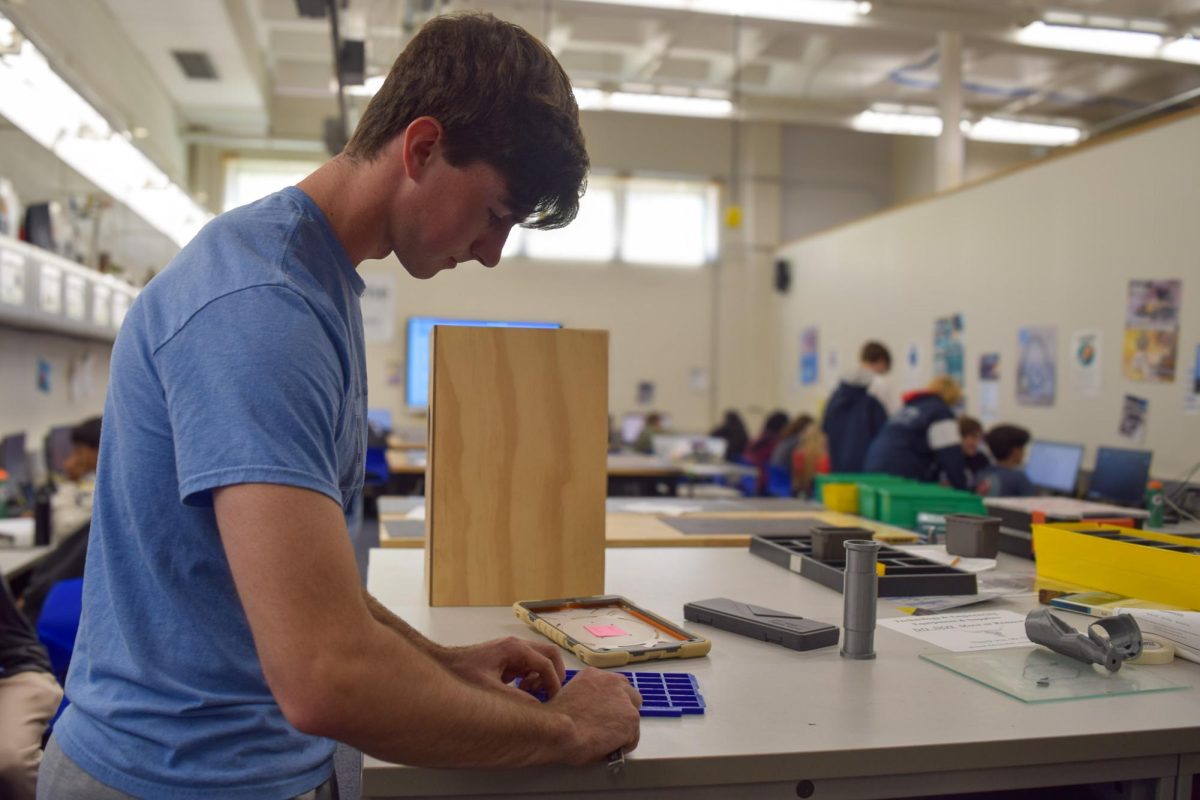Many high schools students are being belabored by the “driving talks” given to them daily when they merely think about leaving their house. The constant, caustic reminders are often heard, but are they understood?
“Drive safe!” “Call me when you get there!” “Wear your seatbelt and don’t speed!”
There must be a new warning: “Don’t text and drive!”
While yes, it grows old to hear the same caveats, drivers must listen, especially when it comes to texting and driving.
According to dosomething.org, there are approximately 18 deaths per day caused by texting while driving, adding up to about 6,000 deaths a year. United States’ Secretary of Transportation, Ray LaHood, titled the issue as a, “national epidemic.”
“I lost my 19 year old cousin to texting and driving. They were in the passenger seat and the driver was texting,” senior Principal Beth Middendorf said.
Middendorf no longer texts and drives. In order to avoid tragedies like this and thousands of others, AT&T has told stories of victims of texting and driving.
“I know I shouldn’t do it, but sometimes, I do it anyway,” junior Calvin Gorczyca stated.
The dangers are clear. Texting and driving leads to accidents– fender benders, fatalities, lost daughters, lost sons.
According to Distracted Driving, a United States Government website of distracted driving, “Text messaging creates a crash risk 23 times worse than driving while not distracted.”
People know about the consequences of sending a text while driving. Not only are they endangering themself as the driver but their passengers and others on the road.
Monash University reported in their study that, “Drivers who use hand-held devices are four times more likely to get into crashes serious enough to injure themselves.” But why don’t we stop?
“People just aren’t patient. They know the dangers, but they still do it,” Gorczyca said.
Drivers feel a sense of urgency when it comes to communicating with their friends and families. More often than not, phones lay comfortably in users’ hands, whether they are in use or not.
“Nothing is that important to respond to while driving. The dangers are you’re looking at your phone and your attention isn’t on the road, where it should be. Teens think that nothing bad can or will happen to them. They have that ‘it’s not going to happen to me’ mentality,” history teacher Teresa America said.
Despite knowing the dangers and consequences of texting and driving, people continue to take the risk.
“I would say it’s almost a blessing getting a ticket for texting and driving. Maybe they’ll stop after they get a ticket,” junior Grayson Koenemann said.
Missouri is one of 11 states without a ban on text messaging on all drivers. Missouri does, however, prohibit drivers 21 and under from texting while driving. Yet, there have been zero tickets written in the city of Chesterfield.
“Enforcement of the law needs to happen. However, it’s hard to enforce the law because you have to check with phone records to see if the driver was actually texting at the time of the ticket. I think awareness will make the big change. The commercials about texting and driving are effective,” Parkway West Resource officer Scott Scoggins said.
AT&T has reached out to teen drivers with the launch of the “It Can Wait” Campaign. Over tens of millions of dollars have been spent to drive home the message: it can wait.
“I thought the commercials were really sad. They’re scary, but that’s what made them effective,” junior Abby Lathrop said.
AT&T has started campaigning to end texting and driving. Their commercials show people’s stories who have either been a victim of texting and driving or close to a victim. The minute long announcement allows viewers to see the fatal impact of texting and driving.
In addition to the AT&T campaign, the AllState Insurance Foundation has also released their own campaign to promote safe driving amongst teenagers.
According to the AllState Foundation, “reaching for a phone while driving increases your risk of crash by nine times.”
If simply reaching for a phone increases a driver’s crash risk tremendously, then imagine the increase that texting creates. Actually, imagine this risk: 23 times greater.
Texting and driving is comparable to drunk driving, another large issue amongst drivers. A drunk driver needs four extra feet to apply the breaks on their vehicle, while texters need 70 additional feet. Chances are, drivers do not have 70 additional feet while driving. It only takes 2-3 seconds to cause an accident.
According to the AllState Foundation’s Driving Distractions, “behind the wheel, one text while driving equals four beers.”
The legal blood alcohol content (BAC) of drivers age 21 and over is .08%. Four beers, in four hours, for an average person is the equivalent to a .05% BAC. With a BAC of .05%, drinkers experience some impairment. This means one text impairs a driver almost as much as legally driving drunk. Drinking and driving is never tolerated, neither should texting and driving.
Ask yourself: is it worth the risk?
You think you can text and drive? Try the texting and driving simulator: http://itcanwaitsimulator.org/simulator.html
To see an AT&T texting and driving commercial, please click this link: http://itcanwait.com/videos/texting-and-driving-it-can-wait/

![Focused on providing exceptional service, sophomore Darsh Mahapatra carefully cleans the door of a customer’s car. Mahapatra has always believed his customers deserve nothing less than the best. “[If] they’re trusting us with their car and our service, then I am convinced that they deserve our 100 percent effort and beyond,” Mahapatra said.](https://pwestpathfinder.com/wp-content/uploads/2025/10/DSC_0018-1200x800.jpg)
![Sophomore Aleix Pi de Cabanyes Navarro (left) finishes up a soccer game while junior Ava Muench (right) warms up for cross country practice. The two came to Parkway West High School as exchange students for the 2025-2026 school year. “The goal for the [exchange] program is to provide opportunities for both Parkway students and our international exchange students to learn about other cultures, build connections and become confident, capable, curious and caring — Parkway’s Four C’s — in the process,” Exchange Program Lead Lauren Farrelly said.](https://pwestpathfinder.com/wp-content/uploads/2025/10/Feature-Photo-1200x800.png)

![Gazing across the stage, sophomore Alexis Monteleone performs in the school theater. The Monteleone family’s band “Monte and the Machine” has been releasing music since 2012, but Alexis started her own solo career in 2024 with the release of her first single, Crying Skies. “My whole family is very musical, [and I especially] love writing [songs with them],” Monteleone said.](https://pwestpathfinder.com/wp-content/uploads/2025/09/DSC7463-1200x798.jpg)
![Amid teaching a lesson to her AP Calculus BC class, Kristin Judd jokes alongside her students in their funny remarks. Judd has always enjoyed keeping the mood light in her classroom, along with on the volleyball court. “[I enjoy] that side talk where you see [or] overhear a conversation and chime in, or somebody says something funny,” Judd said.](https://pwestpathfinder.com/wp-content/uploads/2025/09/image-1200x730.jpg)
![Eyeing the ball, junior Ella McNeal poses for her commitment pictures at Clemson University. McNeal’s commitment comes after months of contact with top Division 1 soccer programs. “ It has taken a lot to get to where I am, but I know that [what] I've already been through is just the beginning, and I can't wait for what is to come,” McNeal said.](https://pwestpathfinder.com/wp-content/uploads/2025/09/IMG_4926-1200x900.jpeg)


![Senior Adam Zerega stands with senior Dexter Brooks by farm equipment. Zerega often worked with friends and family on his farm. “I've been able to go to my family's farm since I was born. I [spend] at least three weekends a month [on the farm], so I'm there all the time,” Zerega said.](https://pwestpathfinder.com/wp-content/uploads/2025/04/IMG_4872-1200x900.jpg)
